Independent learning(yq)
独立写作业的英语
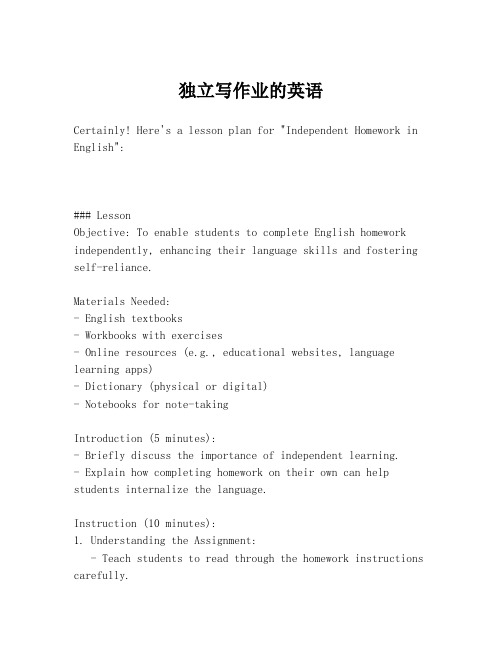
独立写作业的英语Certainly! Here's a lesson plan for "Independent Homework in English":### LessonObjective: To enable students to complete English homework independently, enhancing their language skills and fostering self-reliance.Materials Needed:- English textbooks- Workbooks with exercises- Online resources (e.g., educational websites, language learning apps)- Dictionary (physical or digital)- Notebooks for note-takingIntroduction (5 minutes):- Briefly discuss the importance of independent learning.- Explain how completing homework on their own can help students internalize the language.Instruction (10 minutes):1. Understanding the Assignment:- Teach students to read through the homework instructions carefully.- Encourage them to ask questions if they are unsure about any part of the assignment.2. Setting Goals:- Instruct students to set specific, measurable, achievable, relevant, and time-bound (SMART) goals for their homework completion.3. Planning:- Guide students on how to plan their homework sessions, including time management and prioritization.Activity (15 minutes):- Independent Practice:- Assign a homework task that requires students to use the skills they've learned in class.- Monitor the class, but encourage students to work through problems on their own.Check-In (5 minutes):- Allow students to share their progress and any challenges they faced.- Provide guidance and support as needed.Conclusion (5 minutes):- Summarize the key points of the lesson.- Reiterate the importance of independent learning and homework completion.Homework:- Assign a piece of homework that requires students to applythe skills discussed in class.- Include a mix of comprehension questions, vocabulary exercises, and grammar practice.Assessment:- Monitor the quality and completion of the homework.- Provide feedback to help students improve their independent work habits.This lesson plan is designed to encourage students to take ownership of their learning and to develop the skills necessary for independent study.。
Independent Learning
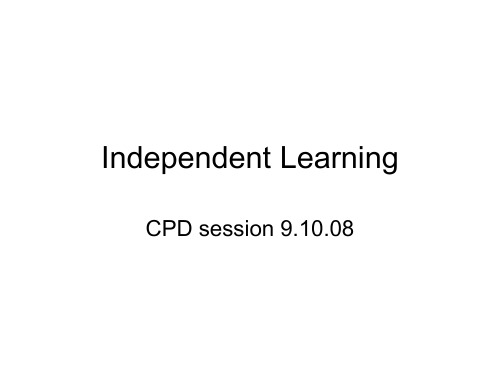
• Thinking about your thinking is important • Emotional Intelligence
EQ matters more than IQ
• `Emotional Intelligence is a master aptitude that profoundly affects all other abilities’ (Daniel Goleman 1996)
Developing Learning
• Government has extolled `lifelong learning’, which requires people to be independent thinkers
I find that whilst many 6th formers appear happy to work independently they generally have poorly developed research skills. Many seem to think that this consists of being directed to a resource and either cutting and pasting or re-writing information without any actual analysis or evaluation of either the source or content. In fact many appear to believe that it is the teacher’s job to provide any & all analysis for them and simply tell them what they need to write in their coursework/exam.
learnt to be an independent learner

learnt to be an independent learner(原创版)目录1.独立学习的重要性2.如何成为一名独立的学习者3.独立学习对个人成长的影响正文一、独立学习的重要性在当今这个信息爆炸的时代,独立学习已经成为每个人必备的能力。
独立学习能力不仅关乎个人的学业成绩,更影响到个人的终身发展。
具备独立学习能力的人,可以在快速变化的社会环境中不断提升自己,适应各种挑战。
因此,学会独立学习是每个人在成长过程中必须掌握的技能。
二、如何成为一名独立的学习者1.培养自主学习意识:独立学习的关键在于自主。
要成为一名独立的学习者,首先要有强烈的学习愿望和目标,明确自己为什么要学习以及要学什么。
2.建立有效的学习计划:为了达到学习目标,我们需要制定合理的学习计划。
学习计划应包括长期目标和短期目标,并且要确保计划的可实行性。
3.掌握科学的学习方法:科学的学习方法可以提高学习效率。
要学会筛选信息,善于利用各种资源,例如图书馆、网络等。
此外,还要掌握一定的记忆方法和思维技巧。
4.培养自律能力:独立学习离不开自律。
要养成按时完成学习任务的习惯,克服拖延症,保持良好的学习状态。
5.学会反思和总结:反思和总结是提高学习效果的重要手段。
要定期对自己的学习进行回顾,发现问题并及时改正。
三、独立学习对个人成长的影响1.提升个人能力:独立学习可以培养个人的思考能力、分析问题和解决问题的能力,这些能力对于个人的职业发展和生活品质具有重要意义。
2.增强自信心:独立学习过程中取得的成就可以增强个人的自信心,有利于个人在面对挑战时保持积极乐观的心态。
3.拓宽人生视野:独立学习可以让我们接触到更多的知识和信息,拓宽我们的视野,让我们更好地理解世界。
4.培养独立人格:独立学习有助于培养我们的独立人格,让我们在面对问题时更加冷静、果断,具备独立判断和决策的能力。
总之,学会独立学习对个人成长具有重要意义。
合作学习(cooperative learning)简述
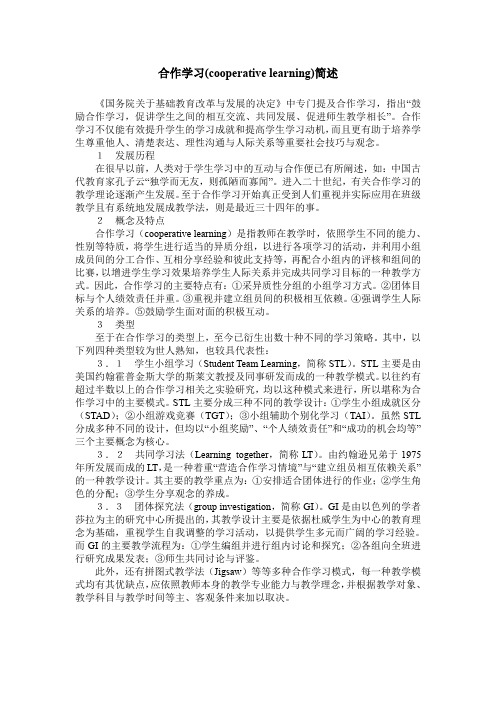
合作学习(cooperative learning)简述《国务院关于基础教育改革与发展的决定》中专门提及合作学习,指出“鼓励合作学习,促讲学生之间的相互交流、共同发展、促进师生教学相长”。
合作学习不仅能有效提升学生的学习成就和提高学生学习动机,而且更有助于培养学生尊重他人、清楚表达、理性沟通与人际关系等重要社会技巧与观念。
1发展历程在很早以前,人类对于学生学习中的互动与合作便已有所阐述,如:中国古代教育家孔子云“独学而无友,则孤陋而寡闻”。
进入二十世纪,有关合作学习的教学理论逐渐产生发展。
至于合作学习开始真正受到人们重视并实际应用在班级教学且有系统地发展成教学法,则是最近三十四年的事。
2概念及特点合作学习(cooperative learning)是指教师在教学时,依照学生不同的能力、性别等特质,将学生进行适当的异质分组,以进行各项学习的活动,并利用小组成员间的分工合作、互相分享经验和彼此支持等,再配合小组内的评核和组间的比赛,以增进学生学习效果培养学生人际关系并完成共同学习目标的一种教学方式。
因此,合作学习的主要特点有:①采异质性分组的小组学习方式。
②团体目标与个人绩效责任并重。
③重视并建立组员间的积极相互依赖。
④强调学生人际关系的培养。
⑤鼓励学生面对面的积极互动。
3类型至于在合作学习的类型上,至今已衍生出数十种不同的学习策略。
其中,以下列四种类型较为世人熟知,也较具代表性:3.1学生小组学习(Student Team Learning,简称STL)。
STL主要是由美国约翰霍普金斯大学的斯莱文教授及同事研发而成的一种教学模式。
以往约有超过半数以上的合作学习相关之实验研究,均以这种模式来进行,所以堪称为合作学习中的主要模式。
STL主要分成三种不同的教学设计:①学生小组成就区分(STAD);②小组游戏竞赛(TGT);③小组辅助个别化学习(TAI)。
虽然STL 分成多种不同的设计,但均以“小组奖励”、“个人绩效责任”和“成功的机会均等”三个主要概念为核心。
八年级下册英语那种学习方式对你最有效
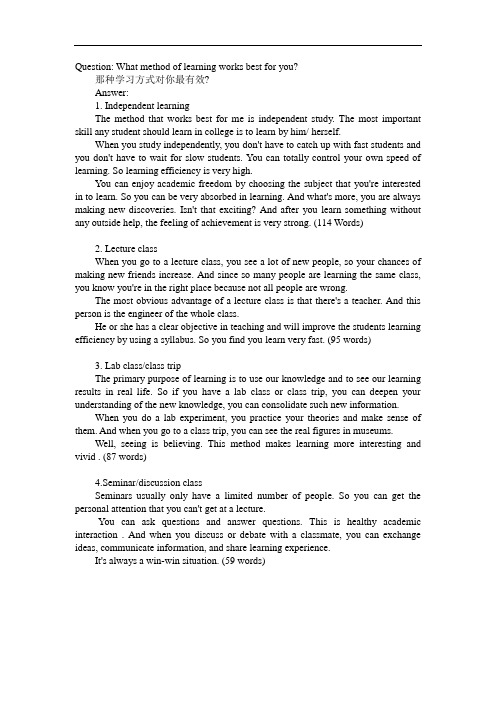
Question: What method of learning works best for you?那种学习方式对你最有效?Answer:1. Independent learningThe method that works best for me is independent study. The most important skill any student should learn in college is to learn by him/ herself.When you study independently, you don't have to catch up with fast students and you don't have to wait for slow students. You can totally control your own speed of learning. So learning efficiency is very high.You can enjoy academic freedom by choosing the subject that you're interested in to learn. So you can be very absorbed in learning. And what's more, you are always making new discoveries. Isn't that exciting? And after you learn something without any outside help, the feeling of achievement is very strong. (114 Words)2. Lecture classWhen you go to a lecture class, you see a lot of new people, so your chances of making new friends increase. And since so many people are learning the same class, you know you're in the right place because not all people are wrong.The most obvious advantage of a lecture class is that there's a teacher. And this person is the engineer of the whole class.He or she has a clear objective in teaching and will improve the students learning efficiency by using a syllabus. So you find you learn very fast. (95 words)3. Lab class/class tripThe primary purpose of learning is to use our knowledge and to see our learning results in real life. So if you have a lab class or class trip, you can deepen your understanding of the new knowledge, you can consolidate such new information.When you do a lab experiment, you practice your theories and make sense of them. And when you go to a class trip, you can see the real figures in museums.Well, seeing is believing. This method makes learning more interesting and vivid . (87 words)4.Seminar/discussion classSeminars usually only have a limited number of people. So you can get the personal attention that you can't get at a lecture.You can ask questions and answer questions. This is healthy academic interaction . And when you discuss or debate with a classmate, you can exchange ideas, communicate information, and share learning experience.It's always a win-win situation. (59 words)。
教育心理学英语词汇

心理(mind)亚里士多德(Aristotle,公元前384年—公元前322年)所著的《灵魂论》(De Anima,又译《精神论》)意识阈(conscious threshold)和统觉团(apperception mass)的比纳(A.Binet)和西蒙(T.Simon)桑代克(E.L.Thorndike)冯特(W.Wundt,梅耶(R.E.Mayer)Educational Psychology加涅(R.M.Gagné)第一章学习的性质与分类艾宾浩斯(H.Ebbinghaus,鲍尔(G.H.Bower)和希尔加德(E.R.Hilgard)倾向(disposition)或能力(capability)行为表现(performance)“学习”(learning)与“表现”(performance)神经元(neuron)树突(dendrite)和轴突(axon)突触(synapse)星形细胞(astrocyte)音素(phoneme)陈述性记忆(declarative memory)和程序性记忆(procedural memory)运作(operations)经验主义(empiricism)洛克(John Locke)、贝克莱(George Berkeley)、休谟(David Hume)反思(reflection)理性主义(rationalism)苏格拉底(Socrates,公元前469—公元前399年)认为,“真理存在于人的灵魂中”;他的学生柏拉图(Plato笛卡儿(Descartes, 1596—1650)和德国哲学家康德(Kant,1724—先天知觉假设(innate perceptual assumptions)行为与联想论(behavioral associationist theories)和认知与组织论(cognitive organizational theories)条件反应(conditioned response)斯金纳(B.F.Skinner)条件反射(conditioned reflex)中性刺激(neutral stimulus)操作条件反应(operant conditioned response)有机体(organism)托尔曼(E.C.Tolman)巴特利特(F.C.Bartlett,坚持信息加工理论的代表人物有西蒙(H.Simon)、安德森(J.R.Anderson)、E.D.加涅(E.D.Gagné)布鲁纳(J.Bruner)、奥苏伯尔、维特罗克(M.C.Wittrock)乔纳森(D.H.Jonassen, 1992)激进建构主义(radical constructivism)、社会建构主义(social constructivism)、社会文化认知(social cultural cognition)、信息加工的建构主义(information processingconstructivism)、社会学建构主义(social constructionism)、控制论系统(cybernetic system)情境性学习(situated learning)社会团体的习俗(practices of community,一类为陈述性知识(declarative knowledge),另一类为程序性知识(procedural knowledge)。
情境学习理论
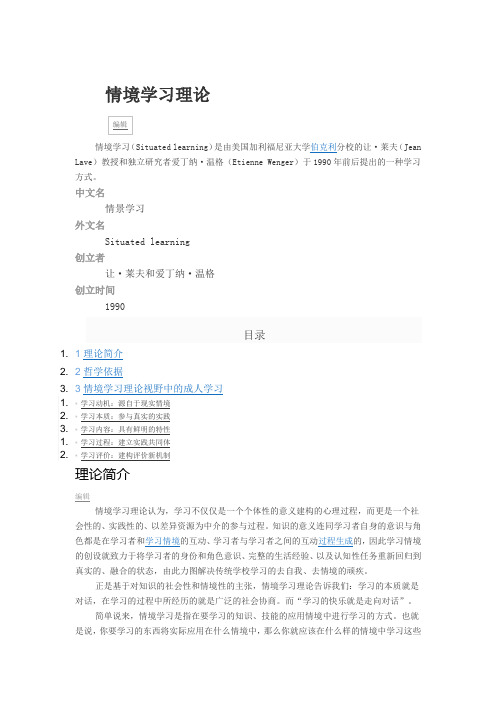
情境学习理论情境学习(Situated learning)是由美国加利福尼亚大学伯克利分校的让·莱夫(Jean Lave)教授和独立研究者爱丁纳·温格(Etienne Wenger)于1990年前后提出的一种学习方式。
中文名情景学习外文名Situated learning创立者让·莱夫和爱丁纳·温格创立时间情境学习理论认为,学习不仅仅是一个个体性的意义建构的心理过程,而更是一个社会性的、实践性的、以差异资源为中介的参与过程。
知识的意义连同学习者自身的意识与角色都是在学习者和学习情境的互动、学习者与学习者之间的互动过程生成的,因此学习情境的创设就致力于将学习者的身份和角色意识、完整的生活经验、以及认知性任务重新回归到真实的、融合的状态,由此力图解决传统学校学习的去自我、去情境的顽疾。
正是基于对知识的社会性和情境性的主张,情境学习理论告诉我们:学习的本质就是对话,在学习的过程中所经历的就是广泛的社会协商。
而“学习的快乐就是走向对话”。
简单说来,情境学习是指在要学习的知识、技能的应用情境中进行学习的方式。
也就是说,你要学习的东西将实际应用在什么情境中,那么你就应该在什么样的情境中学习这些东西。
“在哪里用,就在哪里学。
”譬如,你要学习做菜,就应该在厨房里学习,因为你以后炒菜就是在厨房里。
再如,你要学习讨价还价的技巧,就应该在实际的销售场合学习,因为这一技巧最终是用在销售场合的。
为什么要这样学习呢?因为在莱夫和温格看来,学习不能被简单地视为把抽象的、去情境化的知识从一个人传递给另外一个人;学习是一个社会性的过程,知识在这个过程中是由大家共同建构的;这样的学习总是处于一个特定的情境中,渗透在特定的社会和自然环境中。
在莱夫和温格1991年出版的代表作《情境学习:合法的边缘参与》(Situated Learning: legitimate peripheral participation)这本书中,他们提出了三个核心概念:一是实践共同体(community of practice),它所指的是由从事实际工作的人们组成的“圈子”,而新来者将进入这个圈子并试图从中获得这个圈子中的社会文化实践。
independent learning skill
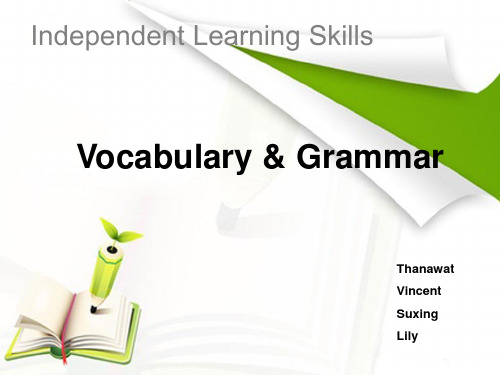
•Students always using the traditional ways to learn the new vocabulary, such as memorizing, using in writing. only a few students choose the way that practicing on website to learn new words. •How to use the vocabulary in academic way has been a great challenge for the modern students. Most of them know a lot of words, but how to use it in the appropriate scene may be a problem. •Sentence fragments and Nominalization are the two difficult grammars when they write essay. students should do more practice about reading books and writing more to over come the problems.
On Independent Learning
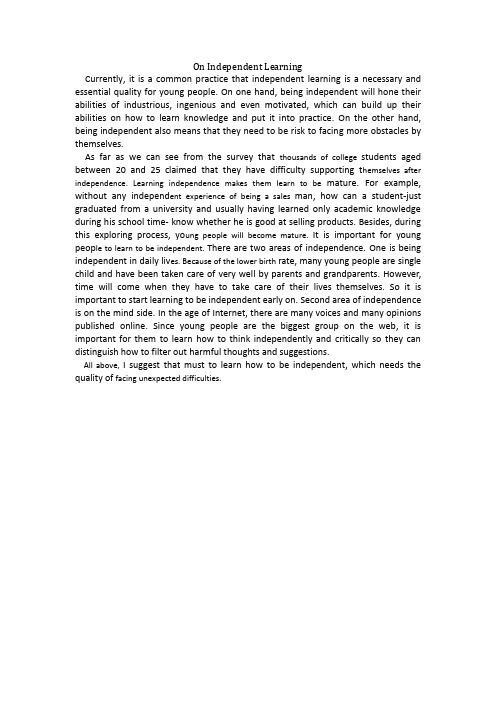
On Independent LearningCurrently, it is a common practice that independent learning is a necessary and essential quality for young people. On one hand, being independent will hone their abilities of industrious, ingenious and even motivated, which can build up their abilities on how to learn knowledge and put it into practice. On the other hand, being independent also means that they need to be risk to facing more obstacles by themselves.As far as we can see from the survey that thousands of college students aged between 20 and 25claimed that they have difficulty supporting t hemselves after independence. Learning independence makes them learn to be mature. For example, without any independ ent experience of being a sales man, how can a student-just graduated from a university and usually having learned only academic knowledge during his school time- know whether he is good at selling products. Besides, during this exploring process, yo ung people will become mature. It is important for young peop le to learn to be independent. There are two areas of independence. One is being independent in daily liv es. Because of the lower birth rate, many young people are single child and have been taken care of very well by parents and grandparents. However, time will come when they have to take care of their lives themselves. So it is important to start learning to be independent early on. Second area of independence is on the mind side. In the age of Internet, there are many voices and many opinions published online. Since young people are the biggest group on the web, it is important for them to learn how to think independently and critically so they can distinguish how to filter out harmful thoughts and suggestions.All above, I suggest that must to learn how to be independent, which needs the quality of facing unexpected difficulties.。
Independent_learning
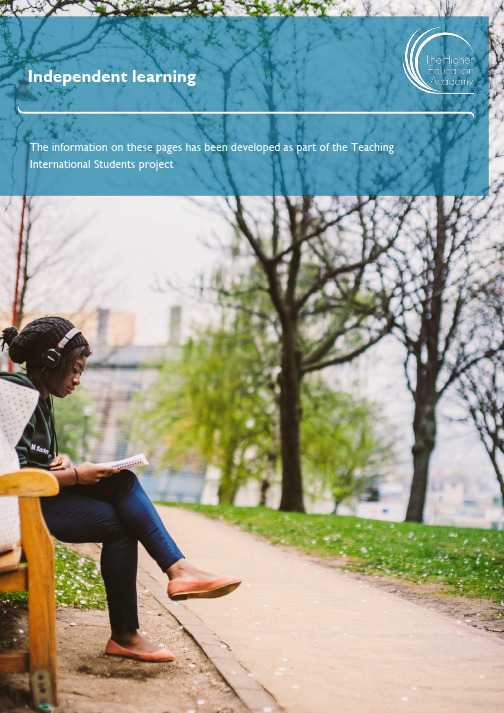
ContentsSection Page1. Introduction 32. The main issues: getting started 32.1 What is ‘independent learning’?32.2 Differences across disciplines 32.3 Differences across cultures 42.4 What are the challenges in encouraging more ‘independent learning’?43. Possible solutions: suggestions for action 53.1 Setting the foundations for independent learning 53.2 Ongoing support – evidence suggests that effective and inspiring teachers: 53.3 Tools for independent learning and self-organisation include: 63.4 Conclusions 64. Useful resources to recommend to students 65. What is the evidence? 66. Related resources 71. IntroductionMany students have trouble making the transition to the more independent learning required at university compared with their previous study. University study requires students to take responsibility for their own learning, to be more self-directed, to make decisions about what they will focus on and how much time they will spend on learning both inside and outside the classroom.This transition may be especially difficult for international students who may be used to more support and direction and even ‘parent-like’ relationships with their teachers at university. It will be useful for them (and all students) to know precisely how they are responsible for their learning in their new setting. This will require them to understand that they need to play a more active role in their own learning and will require greater self-motivation and organisation and greater self-awareness (metacognition) of their learning needs and behaviours.2. The main issues: getting started2.1 What is ‘independent learning’?As is the case with many terms commonly used in higher education learning, such as ‘critical thinking’,‘independent learning’ can mean different things to different people, in different disciplines and in different cultures. Therefore, it is important that this pivotal concept is explained to students so that they know what is required of them within their new context and discipline.Philip Candy, in the now classic text ‘Self-direction for lifelong learning’ (1991), quotes Forster (1972) to define independent learning/ study:1‘Independent study is a process, a method and a philosophy of education:in which a student acquires knowledge by his or her own efforts and develops the ability for inquiry and critical evaluation;2it includes freedom of choice in determining those objectives, within the limits of a given project or program and with the aid of a faculty adviser;3it requires freedom of process to carry out the objectives;4it places increased educational responsibility on the student for the achieving of objectives and for the value of the goals’.This definition clearly places the responsibility for learning in higher education on students, aided by teaching staff and defined by the limits and objectives of the programme.2.2 Differences across disciplinesMany international students may be surprised at how much work they are required to do ‘on their own’ outside of class and, in the absence of specific direction, may not be aware of their own responsibilities. They sometimes complain about the lack of direction generally in their courses. They may be surprised by the low contact hours in many courses, especially in the Humanities and Social Sciences. They may even interpret this as a lack of ‘value for money’ or a lack of interest and support from teachers or their department. It can be useful to spell out in course documents how many hours of work outside of the classroom are expected for each module or unit, and what precisely students are expected to do during this time.Contact hours and the level of autonomy required (or possible) vary considerably across discipline areas. Inmay be required to work on tasks and topics set for them right up to doctoral level, where students work in teams under the explicit direction of their supervisor. In the Humanities and Social Sciences, however, there can be much more autonomy in choosing learning and assignment tasks and topics even from the first year of study.2.3 Differences across culturesThe extent to which independent learning is culturally situated has been hotly debated in the literature. Some describe learners from particular cultures as passive and dependent learners (discussed in Kingston & Forland, 2008). Conversely, others are more positive, such as in a study on self-directed learning by Gieve and Clark (2005) in which Chinese students expressed as much appreciation of the benefits of autonomous learning as their EU counterparts. Interestingly, the current system-wide reform of education in China has as its top priority the development of ‘autonomous’ learners (which is perhaps a more accurate term to use) and is clearly an indication of the importance placed on this attribute for effective learning.It is important, however, to avoid making assumptions about individual students, especially where their home contexts are diverse and undergoing rapid change. International students are likely to be unsure about what is required in their new learning contexts and may at least initially seem to want to know the ‘correct’ methods and answers during this period of uncertainty, but they may be perfectly capable of ‘independence’ and autonomy.The apparently culturally determined dispositions of students in Gieve and Clark’s study were found to be‘flexible’ in the right (new) conditions. This resource will explore what these ‘right conditions’ might be; looking at the actions practitioners might take to enhance students’ independent learning.2.4 What are the challenges in encouraging more ‘independent learning’?This story from a colleague working in China illustrates some of the misunderstandings (in this case, linguistic) around the concept of independent learning:'Independent learning' was translated differently on a poster in a school I visited in China. They had borrowed our list of 'good learning behaviours' but had translated independent learning as 'learning on your own and not distracting or talking to others around you'.This point reinforces the need to be explicit about what precisely students are expected to do and achieve.Most adult learning theory (e.g. Freire, 1972; Knowles, 1990; Mezirow, 1991) and the concept of independent learning itself should be acknowledged as being predominantly ‘Western’. Trahar (2007) gives a personal and academic account of the implications of this on teaching in an international landscape including the potential for a lack of sensitivity to diversity, cultural inviolability and false universalism.Recognising this and using Forster’s (1972) definition of independent learning, it can be seen quite broadly to encompass a variety of situations and contexts where students are interpreting and scaffolding new knowledge and skills independently from those around them. However, this may include situations of group learning where activity may be collaborative and individual learning outcomes similar (or different) but each reached independently. Considered in this light, independent learning does not need to be seen only in terms of learning in ‘isolation’ but also within a community of learners.Certainly, independent learning is a term used frequently in higher education:‘Here, they (lecturers) all the time emphasise self-learning and self-directed learning. But how can we learn when there is no direction at all?’ (International student quoted in Welikala & Watkins, 2008).Here, we see how this concept, if not introduced and exemplified can be seen as confusing. No doubt, students accepted on to higher education courses are already successful learners (Forland, 2006) but in order to expand learners’ e xisting strategies to new contexts mutual effort is required from all participants to learn about and appreciate alternative approaches to learning (Jin & Cortazzi, 2006). The following sections identify some strategies practitioners have described as useful in their practice.3. Possible solutions: suggestions for action3.1 Setting the foundations for independent learning∙Talk to your students about their previous learning and teaching experiences.∙Find out their expectations of the course – how are they expecting to be taught, assessed and how do they expect to facilitate their own learning.∙Talk about your expectations (as a teacher, organiser and facilitator) and the requirements of the course∙Reach a shared understanding of these expectations (see sections on lectures, supervision).∙Talk about independent learning in the context of communities of learners and provide opportunities for developing study communities (through group work, tutor-organised study buddies, online discussion boards).∙The transition for students into new ways of learning can be supported by providing early formative assessment and plenty of opportunities for students to explore their learning with peers and teachers. 3.2 Ongoing support – evidence suggests that effective and inspiring teachers:∙Take time to develop a ‘meta-awareness’ of other cultures (Ryan & Louie, 2007).∙Give an overview of the subject matter so that learners have a framework within which to build their knowledge. Consideration given to internationalising the curriculum will pay dividends as an accessible curriculum will be more easily engaged with by students looking to become autonomous learners.∙Recommend multi-media resources for independent study including texts, audio, internet and video.In the case study linked from the download page for this section, Andrew Cree from Teesside University describes how to build screen-capture movies of teaching slides to allow students multi-media access to his teaching outside class; the additional audio track seemed to benefit students and resulted in reduced failure rates.∙Find ways to motivate students using culturally inclusive pedagogy. ‘Motivating International Students’ by Dolan & Macias (2009) has several suggestions for motivating students in the classroom e.g. beingwelcoming, responsive and explicit. Whilst not necessarily directly affecting students’ skills in independent learning, the connections made between teachers and students in the classroom can motivate students to learn outside the classroom.∙Encourage and build confidence especially in the early stages by providing opportunities for students to bring questions and observations to class which have arisen from their independent reading.∙Remind students of the various support systems available to them especially a few weeks after induction when this useful information may have been forgotten.∙Provide un-assessed opportunities to test out students’ independent learning with tasks set between classes.∙When appropriate, create situations where students can control aspects of classroom learning such as selecting a reading for critical analysis for the next class so that they can practise freedom of choice and objective-setting with peers.∙Gradually move over time from a role as teacher to that of a learning facilitator and teacher (Scharle & Szabó, 2000) as students become more confident independent learners.3.3 Tools for independent learning and self-organisation include:∙E-portfolios (collections of multimedia including text, images, audio, blogs) can be assembled by international students to demonstrate their learning over time (see Hill, 2009).∙Peer-mentoring schemes (UKCISA has a useful guide to setting up schemes, 2008).∙Study skills sessions (goal setting, time management, working to deadlines, self-appraisal, reading).∙Ongoing training in using online information. Crucial to independent learning are the skills and knowledge of effectively using online information. However, some international students find identifying databases and extracting resources difficult (Hughes, 2005). Ongoing support should be available both in the classroom and the library to help students use strategic approaches to finding the information they need, and in the right quantities by defining the scope of their searches.3.4 ConclusionsThe above suggestions are not meant to be prescriptive – you may read these knowing that some will not work in particular local contexts or that others may already have been used for decades to great effect in your department. Jin and Cortazzi (2006) and Kingston and Forland (2008) argue that, by whatever methods, focusing on independent learning should encourage lifelong learning. It should also contribute to a ‘cultural synergy’ where cultures are equally valued in the classroom, and the benefits for learning are reaped by all. 4. Useful resources to recommend to studentsBurnapp, D. (2009). Getting Ahead as an International Student. London: Open University Press.Marshall, L. & Rowland, F. (1998) A Guide to learning independently. London: Open University Press. University of Southampton / UKCISA online resource ‘Prepare for Success’5. What is the evidence?Candy, P. (1991) Self-direction for lifelong learning: a comprehensive guide to theory and practice. San Francisco: Jossey Bass.Dolan, M. & Macias, I. (2009) Motivating international students: A practical guide to aspects of learning and teaching. The Handbook for Economics Lecturers. Economics Network.Freire, P. (1972) Pedagogy of the Oppressed. Harmondsworth: Penguin.Gieve, S. & Clark, R. (2005) ‘The Chinese approach to learning’: Cultural trait or situated response? The case of a self-directed learning programme. System, 33 (2), 261-276.Hill, R. (2009) Case study: Capturing and Enhancing the Experiences of International Students using ePortfolios. Engineering Subject Centre.Hughes, H. (2005) Actions and Reactions: Exploring International Students’ Use of Online Information Resources. Australian Academic and Research Libraries, 36 (4), 169-179.Jin, L. & Cortazzi, M. (2006) Changing Practices in Chinese Cultures of Learning. Language, Culture and Curriculum, 19 (1), 5 – 20.Kingston, E. & Forland, H. (2008) Bridging the Gap in Expectations Between International Students and Academic Staff. Journal of Studies in International Education, 12 (2), 204-221.Knowles, M. (1990) The adult learner: a neglected species (4th ed.) London: Gulf Publishing.Mezirow, J. (1991) Transformative dimensions of adult learning. San Francisco: Jossey Bass.Peelo, M. & Luxon, T. (2007) Designing embedded courses to support international students' cultural and academic adjustment in the UK. Journal of Further and Higher Education, 31 (1), 65 – 76.Ryan, J. & Louie, K. (2007) False dichotomy?: ‘Western’ and ‘Eastern’ concepts of scholarship and learning. Educational Philosophy and Theory, 39 (4), 404-417.Scharle, A. & Szabó, A. (2000) Learner Autonomy. A guide to developing learner responsibility. Cambridge: Cambridge University Press.Trahar, S. (2007) Teaching and Learning: the International Higher Education Landscape – Some Theories and Working Practices. ESCalate Discussion Paper.UKCISA (2008) Mentoring schemes for international students: a practical guide.Welikala, T. & Watkins, C. (2008) Improving Intercultural Learning Experiences in Higher Education. Responding to cultural scripts for learning. London: Institute of Education.6. Related resourcesLearning Issues: Encouraging independent learning from the University of NottinghamLearn Higher: Independent Learning - Resources for Staff。
学生使用电脑 英语作文
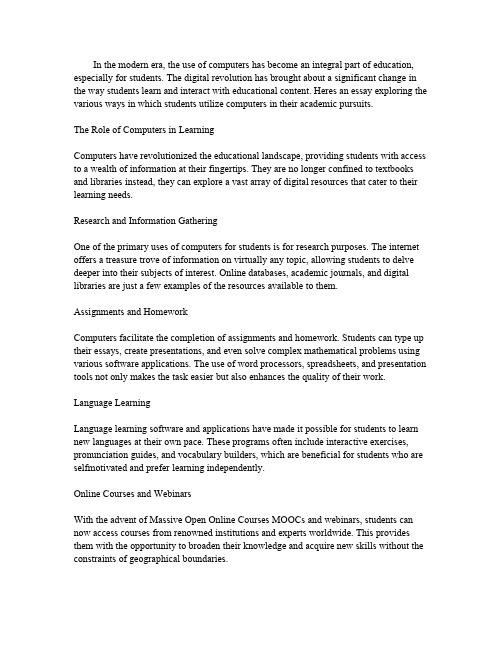
In the modern era,the use of computers has become an integral part of education, especially for students.The digital revolution has brought about a significant change in the way students learn and interact with educational content.Heres an essay exploring the various ways in which students utilize computers in their academic pursuits.The Role of Computers in LearningComputers have revolutionized the educational landscape,providing students with access to a wealth of information at their fingertips.They are no longer confined to textbooks and libraries instead,they can explore a vast array of digital resources that cater to their learning needs.Research and Information GatheringOne of the primary uses of computers for students is for research purposes.The internet offers a treasure trove of information on virtually any topic,allowing students to delve deeper into their subjects of interest.Online databases,academic journals,and digital libraries are just a few examples of the resources available to them.Assignments and HomeworkComputers facilitate the completion of assignments and homework.Students can type up their essays,create presentations,and even solve complex mathematical problems using various software applications.The use of word processors,spreadsheets,and presentation tools not only makes the task easier but also enhances the quality of their work.Language LearningLanguage learning software and applications have made it possible for students to learn new languages at their own pace.These programs often include interactive exercises, pronunciation guides,and vocabulary builders,which are beneficial for students who are selfmotivated and prefer learning independently.Online Courses and WebinarsWith the advent of Massive Open Online Courses MOOCs and webinars,students can now access courses from renowned institutions and experts worldwide.This provides them with the opportunity to broaden their knowledge and acquire new skills without the constraints of geographical boundaries.Collaboration and Group WorkComputers enable students to collaborate on projects and assignments more efficiently. Tools like Google Docs,Microsoft Office365,and various project management software allow students to work together in realtime,share ideas,and edit documents collaboratively.Digital CreativityFor students with a creative bent,computers offer a platform to express themselves through digital art,music production,and video editing.Software like Adobe Creative Suite provides a comprehensive set of tools that cater to a variety of artistic needs.Challenges and ConsiderationsWhile the use of computers in education has numerous benefits,it also presents challenges.Students must be taught to discern credible sources from unreliable ones,and there is a need for digital literacy to ensure they can navigate the digital world safely. Additionally,the potential for distraction and the risk of plagiarism are concerns that educators must address.ConclusionIn conclusion,computers have become an indispensable tool for students,enhancing their learning experience and providing them with opportunities that were previously unimaginable.As we continue to integrate technology into education,it is crucial to ensure that students are equipped with the necessary skills to use these tools effectively and responsibly.。
独立学习重要性的英语作文
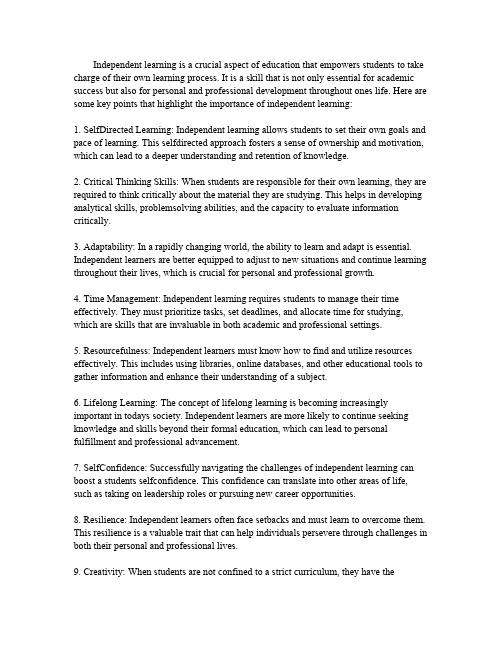
Independent learning is a crucial aspect of education that empowers students to take charge of their own learning process.It is a skill that is not only essential for academic success but also for personal and professional development throughout ones life.Here are some key points that highlight the importance of independent learning:1.SelfDirected Learning:Independent learning allows students to set their own goals and pace of learning.This selfdirected approach fosters a sense of ownership and motivation, which can lead to a deeper understanding and retention of knowledge.2.Critical Thinking Skills:When students are responsible for their own learning,they are required to think critically about the material they are studying.This helps in developing analytical skills,problemsolving abilities,and the capacity to evaluate information critically.3.Adaptability:In a rapidly changing world,the ability to learn and adapt is essential. Independent learners are better equipped to adjust to new situations and continue learning throughout their lives,which is crucial for personal and professional growth.4.Time Management:Independent learning requires students to manage their time effectively.They must prioritize tasks,set deadlines,and allocate time for studying, which are skills that are invaluable in both academic and professional settings.5.Resourcefulness:Independent learners must know how to find and utilize resources effectively.This includes using libraries,online databases,and other educational tools to gather information and enhance their understanding of a subject.6.Lifelong Learning:The concept of lifelong learning is becoming increasingly important in todays society.Independent learners are more likely to continue seeking knowledge and skills beyond their formal education,which can lead to personal fulfillment and professional advancement.7.SelfConfidence:Successfully navigating the challenges of independent learning can boost a students selfconfidence.This confidence can translate into other areas of life, such as taking on leadership roles or pursuing new career opportunities.8.Resilience:Independent learners often face setbacks and must learn to overcome them. This resilience is a valuable trait that can help individuals persevere through challenges in both their personal and professional lives.9.Creativity:When students are not confined to a strict curriculum,they have thefreedom to explore topics that interest them,which can lead to creative thinking and innovative problemsolving.10.Personalized Learning Experience:Each student has unique learning needs and preferences.Independent learning allows for a more personalized approach,where students can focus on areas they are passionate about or where they need additional support.In conclusion,independent learning is not just about acquiring knowledge it is about developing a set of skills that are essential for success in the modern world.It prepares students to be proactive,selfreliant,and adaptable individuals who can contribute positively to society.。
玩手机和写作业的小孩英语
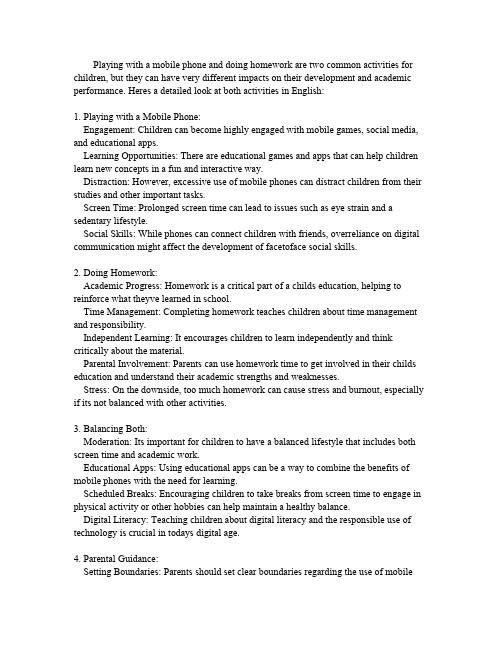
Playing with a mobile phone and doing homework are two common activities for children,but they can have very different impacts on their development and academic performance.Heres a detailed look at both activities in English:1.Playing with a Mobile Phone:Engagement:Children can become highly engaged with mobile games,social media, and educational apps.Learning Opportunities:There are educational games and apps that can help children learn new concepts in a fun and interactive way.Distraction:However,excessive use of mobile phones can distract children from their studies and other important tasks.Screen Time:Prolonged screen time can lead to issues such as eye strain and a sedentary lifestyle.Social Skills:While phones can connect children with friends,overreliance on digital communication might affect the development of facetoface social skills.2.Doing Homework:Academic Progress:Homework is a critical part of a childs education,helping to reinforce what theyve learned in school.Time Management:Completing homework teaches children about time management and responsibility.Independent Learning:It encourages children to learn independently and think critically about the material.Parental Involvement:Parents can use homework time to get involved in their childs education and understand their academic strengths and weaknesses.Stress:On the downside,too much homework can cause stress and burnout,especially if its not balanced with other activities.3.Balancing Both:Moderation:Its important for children to have a balanced lifestyle that includes both screen time and academic work.Educational Apps:Using educational apps can be a way to combine the benefits of mobile phones with the need for learning.Scheduled Breaks:Encouraging children to take breaks from screen time to engage in physical activity or other hobbies can help maintain a healthy balance.Digital Literacy:Teaching children about digital literacy and the responsible use of technology is crucial in todays digital age.4.Parental Guidance:Setting Boundaries:Parents should set clear boundaries regarding the use of mobilephones and the time dedicated to homework.Monitoring Usage:Keeping an eye on the content children are accessing on their phones and the amount of time spent on different activities.Encouraging Breaks:Encouraging children to take regular breaks from studying to relax and recharge can improve focus and productivity.5.The Impact of Technology:Positive Aspects:Technology can be a powerful tool for learning,providing access to a wealth of information and interactive learning experiences.Negative Aspects:Overuse of technology can lead to addiction,distraction from essential tasks,and potential health issues.6.Promoting a Healthy Lifestyle:Physical Activity:Ensuring that children have time for physical activities can help counteract the sedentary nature of screen time.Outdoor Play:Encouraging outdoor play and exploration can stimulate creativity and provide a break from digital devices.7.The Role of Schools:Integration of Technology:Schools can play a role in integrating technology into the curriculum in a way that enhances learning rather than distracting from it. Homework Policies:Schools should have clear policies on homework that consider the balance between academic work and free time.In conclusion,while mobile phones offer numerous benefits and can be a part of a childs educational journey,its essential to ensure that they are used responsibly and do not interfere with the completion of homework and other important developmental activities.。
自学的好处的英语作文
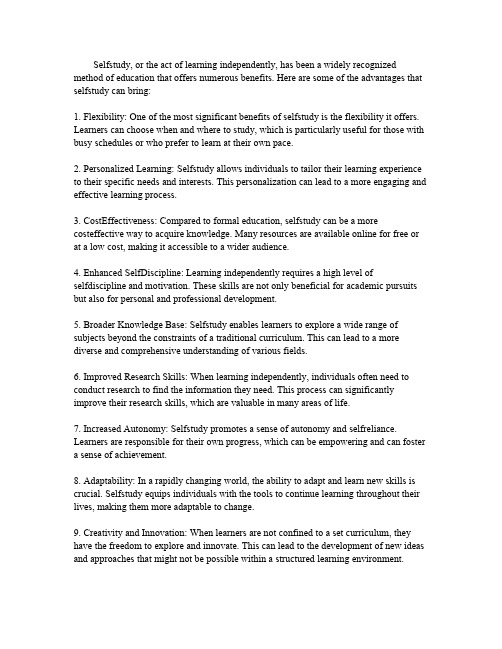
Selfstudy,or the act of learning independently,has been a widely recognized method of education that offers numerous benefits.Here are some of the advantages that selfstudy can bring:1.Flexibility:One of the most significant benefits of selfstudy is the flexibility it offers. Learners can choose when and where to study,which is particularly useful for those with busy schedules or who prefer to learn at their own pace.2.Personalized Learning:Selfstudy allows individuals to tailor their learning experience to their specific needs and interests.This personalization can lead to a more engaging and effective learning process.3.CostEffectiveness:Compared to formal education,selfstudy can be a more costeffective way to acquire knowledge.Many resources are available online for free or at a low cost,making it accessible to a wider audience.4.Enhanced SelfDiscipline:Learning independently requires a high level of selfdiscipline and motivation.These skills are not only beneficial for academic pursuits but also for personal and professional development.5.Broader Knowledge Base:Selfstudy enables learners to explore a wide range of subjects beyond the constraints of a traditional curriculum.This can lead to a more diverse and comprehensive understanding of various fields.6.Improved Research Skills:When learning independently,individuals often need to conduct research to find the information they need.This process can significantly improve their research skills,which are valuable in many areas of life.7.Increased Autonomy:Selfstudy promotes a sense of autonomy and selfreliance. Learners are responsible for their own progress,which can be empowering and can fostera sense of achievement.8.Adaptability:In a rapidly changing world,the ability to adapt and learn new skills is crucial.Selfstudy equips individuals with the tools to continue learning throughout their lives,making them more adaptable to change.9.Creativity and Innovation:When learners are not confined to a set curriculum,they have the freedom to explore and innovate.This can lead to the development of new ideas and approaches that might not be possible within a structured learning environment.10.Lifelong Learning:Selfstudy encourages a lifelong learning mindset.As individuals continue to seek knowledge and skills,they remain engaged and intellectually stimulated, which can contribute to personal growth and satisfaction.In conclusion,selfstudy is a powerful tool for personal and professional development.It offers the freedom to learn at ones own pace,the opportunity to explore a wide range of subjects,and the chance to develop valuable skills such as selfdiscipline,research,and adaptability.Whether for academic advancement or personal enrichment,selfstudy is a journey that can lead to significant growth and achievement.。
Fostering Independent Learning in Kindergarten
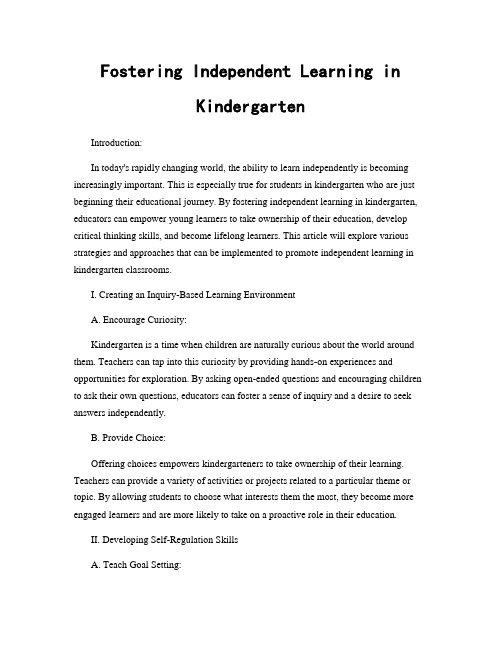
Fostering Independent Learning inKindergartenIntroduction:In today's rapidly changing world, the ability to learn independently is becoming increasingly important. This is especially true for students in kindergarten who are just beginning their educational journey. By fostering independent learning in kindergarten, educators can empower young learners to take ownership of their education, develop critical thinking skills, and become lifelong learners. This article will explore various strategies and approaches that can be implemented to promote independent learning in kindergarten classrooms.I. Creating an Inquiry-Based Learning EnvironmentA. Encourage Curiosity:Kindergarten is a time when children are naturally curious about the world around them. Teachers can tap into this curiosity by providing hands-on experiences and opportunities for exploration. By asking open-ended questions and encouraging children to ask their own questions, educators can foster a sense of inquiry and a desire to seek answers independently.B. Provide Choice:Offering choices empowers kindergarteners to take ownership of their learning. Teachers can provide a variety of activities or projects related to a particular theme or topic. By allowing students to choose what interests them the most, they become more engaged learners and are more likely to take on a proactive role in their education.II. Developing Self-Regulation SkillsA. Teach Goal Setting:In order to become independent learners, kindergarteners need to learn how to set goals. Teachers can guide students in setting achievable goals for themselves, whether it's completing a puzzle, practicing writing their names, or mastering a particular skill. By helping students break down larger tasks into smaller, manageable goals, educators can instill a sense of accomplishment and motivate children to take charge of their own learning.B. Promote Self-Monitoring:Self-monitoring is a vital skill for independent learning. Educators can teach kindergarteners to reflect on their own progress and identify areas of improvement. By encouraging self-assessment and providing opportunities for self-reflection, students can learn how to evaluate their own work and make necessary adjustments. This skill allows children to take responsibility for their own learning and develop a growth mindset.III. Cultivating a Growth MindsetA. Embrace Mistakes and Setbacks:In a kindergarten classroom, it's crucial to create a safe and supportive environment where mistakes and setbacks are seen as an opportunity for growth. Teachers can encourage students to take risks and view mistakes as valuable learning experiences. By praising effort and perseverance rather than just the end result, educators help kindergarteners develop resilience and a desire to keep improving.B. Foster Collaboration:Collaborative learning experiences can greatly enhance independent learning skills. Teachers can create opportunities for kindergarteners to work together on projects or problem-solving tasks. By promoting teamwork and encouraging students to share ideas, they learn from one another and develop the ability to seek help or guidance when needed. Collaboration also builds essential social skills, such as communication and empathy.IV. Utilizing Technology for Independent LearningA. Integrate Educational Apps and Websites:In today's digital age, technology can be a valuable tool for encouraging independent learning. Kindergarten teachers can introduce educational apps and websites that provide interactive learning experiences. These resources can offer engaging activities, virtual field trips, and opportunities to explore various subjects independently. However, it is essential to carefully monitor and select age-appropriate content to ensure effective and safe use of technology in the classroom.B. Teach Digital Literacy:Alongside utilizing technology, it is crucial to teach kindergarteners digital literacy skills. Educators can introduce basic computer skills, internet safety guidelines, and responsible online behavior. By equipping students with these skills, they can navigate online resources independently and become critical consumers of digital information.Conclusion:Fostering independent learning in kindergarten is a crucial step towards empowering young learners to become self-directed, confident, and curious individuals. By creating an inquiry-based learning environment, developing self-regulation skills, cultivating a growth mindset, and utilizing technology, educators can effectively support the journey of kindergarten students towards lifelong learning. By nurturing independence from an early age, we can prepare our young learners to thrive in a world that values critical thinking, adaptability, and self-motivation.。
ICS教学模式的实践与探索
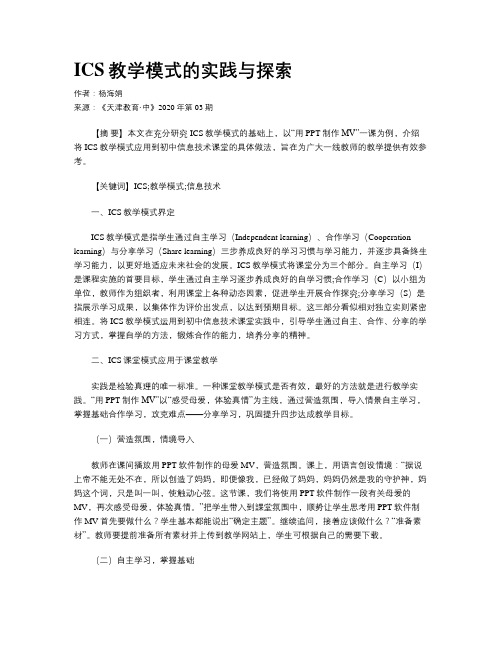
ICS教学模式的实践与探索作者:杨海娟来源:《天津教育·中》2020年第03期【摘要】本文在充分研究ICS教学模式的基础上,以“用PPT制作MV”一课为例,介绍将ICS教学模式应用到初中信息技术课堂的具体做法,旨在为广大一线教师的教学提供有效参考。
【关键词】ICS;教学模式;信息技术一、ICS教学模式界定ICS教学模式是指学生通过自主学习(Independent learning)、合作学习(Cooperation learning)与分享学习(Share learning)三步养成良好的学习习惯与学习能力,并逐步具备终生学习能力,以更好地适应未来社会的发展。
ICS教学模式将课堂分为三个部分。
自主学习(I)是课程实施的首要目标,学生通过自主学习逐步养成良好的自学习惯;合作学习(C)以小组为单位,教师作为组织者,利用课堂上各种动态因素,促进学生开展合作探究;分享学习(S)是指展示学习成果,以集体作为评价出发点,以达到预期目标。
这三部分看似相对独立实则紧密相连。
将ICS教学模式运用到初中信息技术课堂实践中,引导学生通过自主、合作、分享的学习方式,掌握自学的方法,锻炼合作的能力,培养分享的精神。
二、ICS课堂模式应用于课堂教学实践是检验真理的唯一标准。
一种课堂教学模式是否有效,最好的方法就是进行教学实践。
“用PPT制作MV”以“感受母爱,体验真情”为主线,通过营造氛围,导入情景自主学习,掌握基础合作学习,攻克难点——分享学习,巩固提升四步达成教学目标。
(一)营造氛围,情境导入教师在课间播放用PPT软件制作的母爱MV,营造氛围。
课上,用语言创设情境:“据说上帝不能无处不在,所以创造了妈妈,即便像我,已经做了妈妈,妈妈仍然是我的守护神,妈妈这个词,只是叫一叫,使触动心弦。
这节课,我们将使用PPT软件制作一段有关母爱的MV,再次感受母爱,体验真情。
”把学生带入到課堂氛围中,顺势让学生思考用PPT软件制作MV首先要做什么?学生基本都能说出“确定主题”。
q-learning公式解释
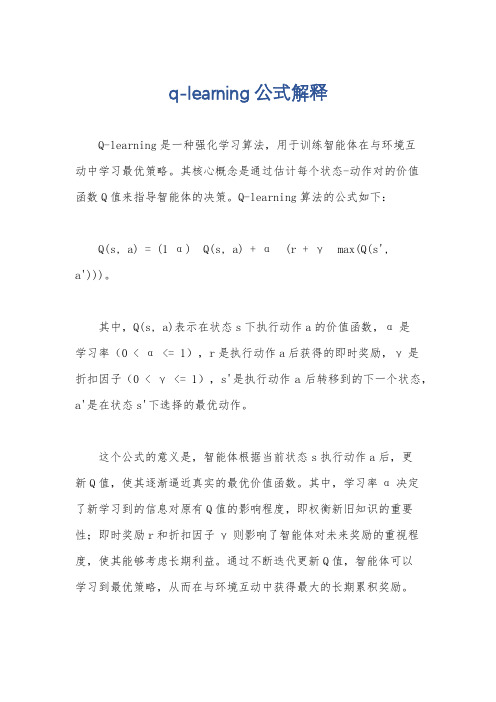
q-learning公式解释
Q-learning是一种强化学习算法,用于训练智能体在与环境互
动中学习最优策略。
其核心概念是通过估计每个状态-动作对的价值
函数Q值来指导智能体的决策。
Q-learning算法的公式如下:
Q(s, a) = (1 α) Q(s, a) + α (r + γ max(Q(s',
a')))。
其中,Q(s, a)表示在状态s下执行动作a的价值函数,α是
学习率(0 < α <= 1),r是执行动作a后获得的即时奖励,γ是
折扣因子(0 < γ <= 1),s'是执行动作a后转移到的下一个状态,a'是在状态s'下选择的最优动作。
这个公式的意义是,智能体根据当前状态s执行动作a后,更
新Q值,使其逐渐逼近真实的最优价值函数。
其中,学习率α决定
了新学习到的信息对原有Q值的影响程度,即权衡新旧知识的重要性;即时奖励r和折扣因子γ则影响了智能体对未来奖励的重视程度,使其能够考虑长期利益。
通过不断迭代更新Q值,智能体可以
学习到最优策略,从而在与环境互动中获得最大的长期累积奖励。
independent learning method
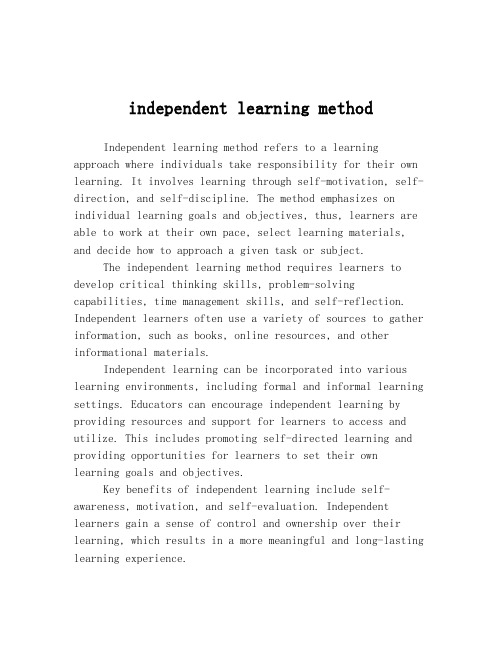
independent learning methodIndependent learning method refers to a learning approach where individuals take responsibility for their own learning. It involves learning through self-motivation, self-direction, and self-discipline. The method emphasizes on individual learning goals and objectives, thus, learners are able to work at their own pace, select learning materials, and decide how to approach a given task or subject.The independent learning method requires learners to develop critical thinking skills, problem-solving capabilities, time management skills, and self-reflection. Independent learners often use a variety of sources to gather information, such as books, online resources, and other informational materials.Independent learning can be incorporated into various learning environments, including formal and informal learning settings. Educators can encourage independent learning by providing resources and support for learners to access and utilize. This includes promoting self-directed learning and providing opportunities for learners to set their own learning goals and objectives.Key benefits of independent learning include self-awareness, motivation, and self-evaluation. Independent learners gain a sense of control and ownership over their learning, which results in a more meaningful and long-lasting learning experience.。
8大途径
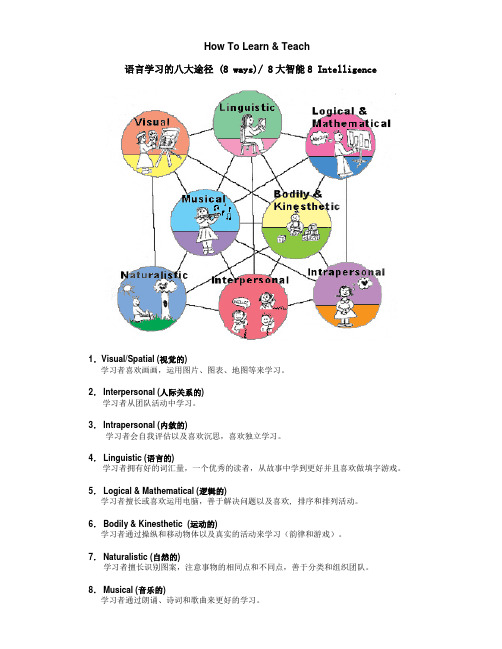
语言学习的八大途径 (8 ways)/ 8大智能8 Intelligence1.Visual/Spatial (视觉的)学习者喜欢画画,运用图片、图表、地图等来学习。
2. Interpersonal (人际关系的)学习者从团队活动中学习。
3. Intrapersonal (内敛的)学习者会自我评估以及喜欢沉思,喜欢独立学习。
4. Linguistic (语言的)学习者拥有好的词汇量,一个优秀的读者,从故事中学到更好并且喜欢做填字游戏。
5. Logical & Mathematical (逻辑的)学习者擅长或喜欢运用电脑,善于解决问题以及喜欢, 排序和排列活动。
6. Bodily & Kine sthetic (运动的)学习者通过操纵和移动物体以及真实的活动来学习(韵律和游戏)。
7. Naturalistic (自然的)学习者擅长识别图案,注意事物的相同点和不同点,善于分类和组织团队。
8. Musical (音乐的)学习者通过朗诵、诗词和歌曲来更好的学习。
EF Small Stars Teaching MethodologyEclectic整合式教学方法∙交际教学法(Communicative method)采用真实、地道的语言材料,通过画画、表演、听说读方式,主张句型加情景来学习语言。
∙直接教学法(Direct method)100%使用英语教学,训练孩子学会如何运用英语思考及沟通。
着重听说先行于其它各项技能。
∙全身反应教学法(Total Physical Response)完全以英语授课,凭借丰富的肢体语言、实物教具、图片等,让完全没学过英语的孩子充分了解每句话的意思。
∙任务教学法(Task-ba sed learning)把课堂活动演变为一个个特定的任务,以孩子为主导、任务为核心,倡导“为用而学、学了就用”。
∙故事教学法(Story-Based Approach)让孩子通过接触有完整意义的语言材料(故事、诗歌等),在阅读或听力理解的过程中逐步自觉意识到某一语法结构规则。
- 1、下载文档前请自行甄别文档内容的完整性,平台不提供额外的编辑、内容补充、找答案等附加服务。
- 2、"仅部分预览"的文档,不可在线预览部分如存在完整性等问题,可反馈申请退款(可完整预览的文档不适用该条件!)。
- 3、如文档侵犯您的权益,请联系客服反馈,我们会尽快为您处理(人工客服工作时间:9:00-18:30)。
1.to practice the abilityto speak out their ideas
1.understand the reading passage and know two types of learning--- correspondence course and e-learning
2.be familiar with the new words and phrases and try to use them
Ask questions to get them to think or give them key words or samples
3.
Some students may not be interested in the monotonous article.
Give some vivid examples.
Lesson Plan of Unit2, Module 1,OxfordEnglishBook 3
Name (English)
Christine
Lesson No.
Unit 2, Module 1
Date
Sep 30, Fri, 2011
Name (Pinyin)
Yin Qin
Level
Senior 2
T-- S
6 mins
1. The teacher checks the word understanding :matching exercises
2.The teacher gets the student to read the first paragraph and checks their understanding by asking questions on the 3 cases given by the teacher about the function of independent learning
2. The students give the synopsis by doing the match work.
3. The teacher may show the structure of the article on the blackboard for reference.
3
Study
Tohelp the students further understand the words , and then atudy the papragraph 1 .
What doesindependent learningmean to you?
2
Study
For the students tห้องสมุดไป่ตู้ read the article
S – S
S -- T
4mins
1. The teacher gives instructions.(3mins for reading)
Main Lesson Focus
Reading
School
YangjingSenior High School
LessonLength
40 minutes
Teaching method
PPP
Main Lesson Aim(s)For students to…
Subsidiary Aim(s)For students to…
Personal Aims
1. to tryto get the students involved in the reading activity as much as possible
Language Analysis
Since the article is clear in structure and not difficult to understand, it is not challenging to them. Actually, students don’t have much direct experience in such non-traditional way of learning. Therefore, it will probably be a class of one(teacher), which is a failure to a teacher.
Procedure/section
Stage/
Activity
Objective
Purpose(s) of stage
Interaction
Time
Procedure
1
Engage
Toarouse the students’ interest in the lesson
T --S
2mins
1. The teacher asks them predict the content.
Anticipated Problems and Solutions
Problem
Solution
1.
The class is a new one.The students are not familiar with each other. The students are not accustomed to the teacher’s English .
Try to get them to understand the teachers’ instruction. Native language or simple English will be used when necessary.
2.
Somestudents may not be able tovoice their ideas.
3.Sum-up p1Introduction;Advantages, Function
4
Engage
For the students to understand what correspondence course means in para 2
